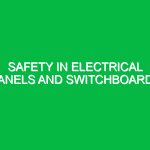In today’s fast-paced world, where technology and electricity are integral to our daily lives, ensuring safety around electrical systems is paramount. Electrical safety signs and labels play a vital role in the Health, Safety, and Environment (HSE) domain, serving as critical communication tools that inform and guide individuals in potentially hazardous situations. In this article, we will explore what electrical safety signs and labels are, their significance, associated hazards, best practices for safety, and the regulations that govern their usage.
Defining Electrical Safety Signs and Labels
Electrical safety signs and labels are visual aids designed to convey essential information regarding electrical hazards and safety precautions. They come in various forms, including warning signs, prohibition signs, mandatory signs, and informational labels. These signs can be found in workplaces, construction sites, laboratories, and even in residential areas where electrical installations are present. Their primary purpose is to protect individuals from electrical risks, ensuring that they are aware of potential dangers and the necessary precautions to take.
Significance in HSE
The relevance of electrical safety signs and labels in the HSE domain cannot be overstated. They serve several critical functions:
- Prevention of Accidents: By clearly communicating potential hazards, these signs help prevent accidents and injuries related to electrical systems.
- Compliance with Regulations: Many regulatory bodies require specific signage to be displayed in workplaces, ensuring compliance with health and safety laws.
- Enhanced Awareness: They raise awareness among employees and visitors about the presence of electrical hazards, promoting a culture of safety.
Identifying Hazards and Risks Associated with Electrical Safety Signs and Labels
Electrical hazards are diverse and can pose significant risks. Understanding these hazards is crucial for effective safety management. Here are some common electrical hazards associated with improper signage or the absence of safety labels:
Shock Hazards
One of the most immediate risks is electrical shock, which can occur when individuals come into contact with live wires or faulty equipment. The severity of electrical shock can range from mild discomfort to fatal injuries. Inadequate signage in these areas can lead to unintentional contact with energized parts.
Arc Flash and Arc Blast
Arc flash is a dangerous condition that occurs when an electrical fault creates a high-temperature plasma arc. This can lead to severe burns, hearing loss, and even blindness. Arc blast, on the other hand, involves a rapid expansion of air that can result in explosive force. Both phenomena can occur in the absence of adequate warning signs that indicate high-risk areas.
Overloading and Fire Risks
Electrical systems can overheat due to excessive current, leading to equipment failure and potential fires. Signs that indicate the maximum load capacity and warnings against overloading are essential to mitigate these risks. Without proper labeling, individuals may unknowingly overload circuits, creating dangerous conditions.
Inadequate Training and Awareness
In many cases, a lack of knowledge about electrical safety can lead to mishaps. Clear signs and labels can help bridge the knowledge gap, informing individuals about safe practices and the importance of using personal protective equipment (PPE). Failure to communicate these requirements may lead to serious injuries.
Best Practices for Safety: Actionable Advice
Implementing effective electrical safety practices involves not only using appropriate signage but also fostering a comprehensive safety culture. Here are some best practices:
Regular Training and Education
Investing in regular training sessions for employees can significantly reduce electrical hazards. Training should cover the interpretation of electrical safety signs and labels, safe work practices, and emergency response procedures. For instance, a construction site I visited once had a mandatory training program, and it was evident that workers were much more aware of their surroundings and the risks involved.
Proper Placement of Signs
For electrical safety signs and labels to be effective, they must be strategically placed where they are easily visible. High-traffic areas, near electrical panels, and at the entrance of hazardous zones are ideal locations. Consider the height and angle of the signs to ensure they are perceived by individuals from various perspectives.
Regular Maintenance and Inspection
Electrical safety signs can degrade over time due to exposure to weather, wear, and tear. Regular inspections of signs and labels are crucial to ensure they remain legible and effective. In one facility I worked with, a routine check revealed several faded signs that needed replacement, which ultimately improved overall safety compliance.
Use of Standardized Signs
Adhering to standardized sign formats and symbols can enhance understanding. The use of universally recognized symbols, such as those defined by the Occupational Safety and Health Administration (OSHA) or the International Organization for Standardization (ISO), ensures that individuals can quickly comprehend the messages conveyed.
Regulatory Standards Governing Electrical Safety Signs and Labels
Various regulations and standards govern the use of electrical safety signs and labels to ensure the safety of individuals in different environments. Here are a few key regulations:
Occupational Safety and Health Administration (OSHA)
OSHA sets forth standards that require employers to provide a safe workplace, which includes the appropriate signage to warn employees of electrical hazards. Their regulations specify the colors, shapes, and formats of safety signs to ensure consistency and clarity.
National Fire Protection Association (NFPA)
The NFPA provides guidelines for electrical safety, including the NFPA 70E standard, which addresses electrical safety requirements for work practices. This standard emphasizes the importance of proper labeling to communicate hazards effectively.
American National Standards Institute (ANSI)
ANSI develops and publishes standards for safety signs and symbols, ensuring that businesses and organizations maintain a uniform approach to electrical safety signage. Their guidelines help in creating signs that are easily understood regardless of the audience’s background.
Conclusion: The Importance of Electrical Safety Signs and Labels
In conclusion, electrical safety signs and labels are indispensable tools in the realm of Health, Safety, and Environment (HSE). They play a crucial role in preventing accidents, ensuring compliance with regulations, and fostering a culture of safety. By understanding the hazards associated with electrical systems and implementing best practices for signage, organizations can mitigate risks and protect their employees and visitors. As we continue to embrace technological advancements, the importance of effective communication through electrical safety signs and labels will only grow. Prioritizing these safety measures not only saves lives but also cultivates a safer working environment for everyone involved.


